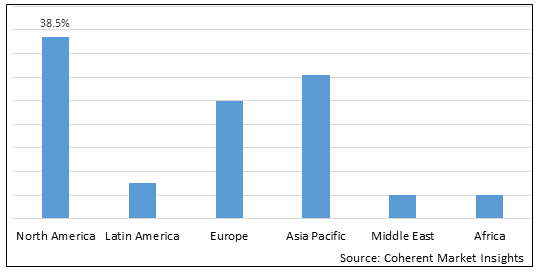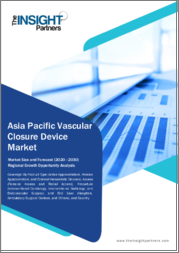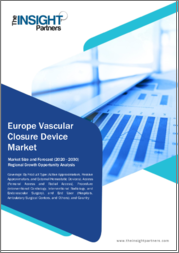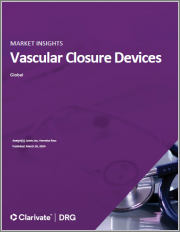
|
시장보고서
상품코드
1402601
혈관 폐쇄 장치 시장 : 제품 유형별, 액세스별, 구멍 사이즈별, 최종 사용자별 및 지역별Vascular Closure Device Market, by Product Type, By Access, By Hole Size By End User and by Region |
||||||
세계의 혈관 폐쇄 장치 시장 규모는 2023년 12억 8,380만 달러로 평가되었고, 2030년에는 19억 4,320만 달러에 이를 것으로 예측되며, 예측 기간 중 CAGR은 6.1%로 전망됩니다.
| 보고 범위 | 보고서 세부정보 | ||
|---|---|---|---|
| 기준년 | 2022년 | 시장 규모(2023년) | 12억 8,380만 달러 |
| 실적 데이터 | 2018-2021년 | 예측 기간 | 2023-2030년 |
| 예측 기간의 CAGR | 6.10% | 시장 규모 예측(2030년) | 19억 4,320만 달러 |

혈관 폐쇄 장치는 혈관 조영술 및 혈관 성형술과 같은 심장혈관 치료 후 동맥 천자를 밀봉하는 데 도움이 됩니다. 기계적 또는 생물학적 수단에 의해 자연적인 응고를 촉진함으로써 천자 부위의 출혈을 막는 데 도움이 됩니다. 세계 혈관 폐쇄 장치 사용량은 세계 인터벤셔널 심장 병학 및 방사선 치료의 성장과 함께 증가하고 있습니다. 환자의 쾌적성 향상, 입원 기간 단축, 수동 압박 방법에 비해 합병증 발생률 저하로 혈관 폐쇄 장치는 혈관 접근 부위 관리에 필수적입니다.
시장 역학 :
세계의 혈관 폐쇄 장치 시장은 인구 역학 변화에서 기술 진보에 이르기까지 다양한 요인이 겹치고 크게 성장하고 있습니다. 이 성장에 크게 기여하는 것은 생리적 노화로 심혈관 질환에 걸리기 쉬운 노인 인구 증가입니다. 노인 인구가 증가함에 따라 심혈관 질환의 발생률도 증가하여 진단 및 치료 절차 후 효과적인 혈관 폐쇄 장치에 대한 수요가 증가하고 있습니다. 동시에 건강 관리 부문 전체에서 저침습 수술(MIS)로의 전환이 현저해지고 있습니다. MIS 수술은 전통적인 개복 수술에 비해 감염 위험을 줄이고 입원 기간을 단축하며 환자의 회복을 가속화합니다. 혈관 폐쇄 장치는 신속한 지혈, 보행 시간 단축, 환자의 편안함 향상 등 이들 수술에 있어서 중요한 역할을 합니다.
기구 기술의 진보는 또한 매우 중요하며, 보다 높은 효능과 절차 후 합병증 위험을 감소시키는 기구로 이어지고 있습니다. 디자인과 소재의 개량에 의해 밀폐성이 향상되어, 다양한 해부학적 형상이나 천자 사이즈에 적합한 제품이 탄생했습니다. 반면에 이러한 첨단 장비와 관련된 높은 비용은 보급 장벽이 될 수 있습니다. 특정 헬스케어 시스템에서의 상환 부족은 이 문제를 더욱 악화시켜 환자가 이러한 기술을 이용하기 어렵게 하고 있습니다. 수작업으로 인한 압박과 같은 지혈을 달성하기 위한 기존의 대체 수단은 존재하지만, 회복에 시간이 걸리거나 합병증의 위험이 높아지는 경우가 많습니다.
이 시장은 특히 헬스케어에 대한 투자와 헬스케어 인프라의 강화가 진행되고 있는 신흥국에서 큰 비즈니스 기회로 축복받고 있습니다. 경 카테터 대동맥 판막 치환술(TAVR)과 같은 복잡한 절차에서 일반적으로 사용되는 생분해성 물질로 만들어진 것과 같은 현재 진행 중인 신규 장치의 개발에는 큰 가능성이 있습니다. 전반적으로 비용 및 상환 문제와 같은 과제는 여전히 남아 있지만 기술 발전과 MIS에 대한 수요 증가와 같은 혈관 폐쇄 장치의 장점은 앞으로도 시장 성장을 가속할 것으로 보입니다.
예를 들어, 2021년 1월, 더 나은 환자 결과를 촉진하는 혁신적인 의료 솔루션 제공에 주력하는 의료 기술 회사인 Haemonetics Corporation은 혈관 폐쇄 시스템의 제조업체인 비공개 회사 Cardiva Medical, Inc.를 인수하는 정식 계약을 체결했습니다.
본 조사의 주요 특징
- 본 보고서에서는 세계의 혈관 폐쇄 장치 시장을 상세하게 분석하여 2022년을 기준년으로 한 예측기간(2023-2030년) 시장 규모 및 복합 연간 성장률(CAGR%)을 제공합니다.
- 또한 다양한 부문에 걸친 잠재적인 수익 기회를 밝히고 이 시장에 대한 매력적인 투자 제안의 행렬에 대해 설명합니다.
- 또한 시장 성장 촉진요인, 억제요인, 기회, 신제품 출시 및 승인, 시장 동향, 지역별 전망, 주요 기업이 채용하는 경쟁 전략 등에 관한 주요 인사이트도 제공합니다.
- 엔터프라이즈 하이라이트, 제품 포트폴리오, 주요 하이라이트, 실적, 전략 등의 매개변수를 기반으로 세계 혈관 폐쇄 장치 시장의 주요 기업을 프로파일링합니다.
- 이 보고서의 인사이트를 통해 마케팅 담당자와 기업 경영진이 향후 제품 출시, 유형 업그레이드, 시장 확대, 마케팅 전술에 대한 정보를 기반으로 의사 결정을 내릴 수 있습니다.
- 세계의 혈관 폐쇄 장치 시장 보고서는 투자자, 공급업체, 제품 제조업체, 유통업체, 신규 참가자, 재무 분석가 등 이 업계의 다양한 이해관계자를 지원합니다.
- 이해관계자들은 세계의 혈관 폐쇄 장치 시장 분석에 사용되는 다양한 전략 매트릭스를 통해 의사결정이 용이해집니다.
목차
제1장 조사 목적 및 전제 조건
- 조사 목적
- 전제 조건
- 약어
제2장 시장 전망
- 보고서 설명
- 시장 정의 및 범위
- 주요 요약
- Coherent Opportunity Map(COM)
제3장 시장 역학, 규제 및 동향 분석
- 시장 역학
- 고령자 인구 증가
- 혈관성형술의 급증
- 심혈관질환의 이환율 증가
- 저침습 수술 수요 증가
- 영향 분석
- 주요 하이라이트
- 규제 시나리오
- 제품 출시 및 승인
- PEST 분석
- Porter's Five Forces 분석
- 인수 및 합병(M&A) 시나리오
제4장 세계의 혈관 폐쇄 장치 시장-코로나 바이러스(COVID-19) 팬데믹의 영향
- 신형 코로나 바이러스 감염증(COVID-19)의 역학
- 공급측 및 수요측 분석
- 경제적 영향
제5장 세계의 혈관 폐쇄 장치 시장-제품 유형별(2023-2030년)
- 수동적 혈관 폐쇄 장치
- 능동적 혈관 폐쇄 장치
- 체외지혈기구
제6장 세계의 혈관 폐쇄 장치 시장-액세스별(2023-2030년)
- 대퇴부
- 방사상
제7장 세계의 혈관 폐쇄 장치 시장-구멍 사이즈별(2023-2030년)
- 작은 구멍
- 큰 구멍
제8장 세계의 혈관 폐쇄 장치 시장-최종 사용자별(2023-2030년)
- 병원
- 외래수술센터(ASC)
- 기타
제9장 세계의 혈관 폐쇄 장치 시장-지역별(2023-2030년)
- 북미
- 미국
- 캐나다
- 유럽
- 독일
- 영국
- 스페인
- 프랑스
- 이탈리아
- 러시아
- 기타 유럽
- 아시아태평양
- 중국
- 인도
- 일본
- 호주
- 한국
- ASEAN
- 기타 아시아태평양
- 라틴아메리카
- 브라질
- 아르헨티나
- 멕시코
- 기타 라틴아메리카
- 중동
- GCC 국가
- 이스라엘
- 기타 중동
- 아프리카
- 남아프리카
- 북아프리카
- 중앙 아프리카
제10장 경쟁 구도
- Abbott
- Cardiva Medical Inc.
- Terumo Corporation
- Johnson & Johnson Services Inc.
- Braun SE
- Biotronik SE & Co. KG
- MicroPort Scientific Corporation
- ConforMIS, Inc.
- Medtronic
- Transluminal Technologies LLC
- Cardinal Health
- Teleflex Incorporated
- Vasorum Ltd.
- Tricol Biomedical
- Merit Medical Systems, Inc.
- Stryker
제11장 섹션
- 조사 방법
- 출판사에 대해
The global vascular closure device market size is expected to reach US$ 1,943.2 Mn by 2030, from US$ 1,283.8 Mn in 2023, at a CAGR of 6.1% during the forecast period.
| Report Coverage | Report Details | ||
|---|---|---|---|
| Base Year: | 2022 | Market Size in 2023: | US$ 1,283.8 Mn |
| Historical Data for: | 2018 to 2021 | Forecast Period: | 2023 - 2030 |
| Forecast Period 2023 to 2030 CAGR: | 6.10% | 2030 Value Projection: | US$ 1,943.2 Mn |

Vascular closure devices help seal arterial punctures after a cardiovascular procedure such as angiography or angioplasty. They help stop bleeding at the puncture site by accelerating natural clotting through mechanical or biological means. The global usage of vascular closure devices has been increasing with growth in interventional cardiology and radiology procedures worldwide. Improved patient comfort, reduced hospital stay times, and lower complication rates compared to manual compression methods have made vascular closure devices an integral part of vascular access site management.
Market Dynamics:
The global vascular closure device market is growing substantially, propelled by a confluence of factors ranging from demographic shifts to technological progress. A significant contributor to this growth is the rising geriatric population which is more susceptible to cardiovascular diseases due to physiological aging. As the elderly population grows, so does the incidence of cardiovascular conditions, thereby increasing the demand for effective vascular closure devices following diagnostic and therapeutic procedures. Simultaneously, a notable shift towards minimally invasive surgeries (MIS) across the healthcare sector. MIS procedures reduce the risk of infection, shorten hospital stays, and speed up patient recovery times compared to traditional open surgeries. Vascular closure devices play a key role in these procedures by providing rapid hemostasis, reducing time to ambulation, and enhancing patient comfort.
Advancements in device technology have also been pivotal, leading to devices that offer greater efficacy and a reduced risk of post-procedure complications. Enhanced designs and materials have yielded products with improved sealing capabilities and compatibility with various anatomies and puncture sizes. On the other side of the spectrum, the high costs associated with these advanced devices can act as a barrier to their widespread adoption. The lack of reimbursement in certain healthcare systems further exacerbates this issue, making it challenging for patients to access these technologies. While existing alternatives for achieving hemostasis, such as manual compression, exist, they often come with longer recovery times and elevated risks of complications, thereby providing an opening for the adoption of advanced vascular closure devices.
The market is ripe with opportunities, especially within emerging economies that are currently witnessing increased healthcare investments and enhancements to their healthcare infrastructure. The significant potential in the ongoing development of novel devices, including those made from biodegradable materials, commonly used in complex procedures like transcatheter aortic valve replacement (TAVR).Overall, while challenges like cost and reimbursement issues persist, the benefits of vascular closure devices, including the advancements in technology and rising demands for MIS, are likely to continue to drive market growth.
For instance, in January 2021, Haemonetics Corporation, a medical technology company focused on delivering innovative medical solutions to drive better patient outcomes, entered into a definitive agreement to acquire privately-held Cardiva Medical, Inc., a manufacturer of vascular closure systems.
Key features of the study:
- This report provides in-depth analysis of the global vascular closure device market, and provides market size (US$ Mn) and compound annual growth rate (CAGR%) for the forecast period (2023-2030), considering 2022 as the base year
- It elucidates potential revenue opportunities across different segments and explains attractive investment proposition matrices for this market
- This study also provides key insights about market drivers, restraints, opportunities, new product launches or approval, market trends, regional outlook, and competitive strategies adopted by key players
- It profiles key players in the global vascular closure device market based on the following parameters - company highlights, products portfolio, key highlights, financial performance, and strategies
- Key companies covered as a part of this study include Abbott, Cardiva Medical Inc., Terumo Corporation, Johnson & Johnson Services Inc., B. Braun SE, Biotronik SE & Co. KG, MicroPort Scientific Corporation, ConforMIS, Inc., Medtronic, Transluminal Technologies LLC, Cardinal Health, Teleflex Incorporated, Vasorum Ltd., Tricol Biomedical, Merit Medical Systems, Inc., Stryker
- Insights from this report would allow marketers and the management authorities of the companies to make informed decisions regarding their future product launches, type up-gradation, market expansion, and marketing tactics
- The global vascular closure device market report caters to various stakeholders in this industry including investors, suppliers, product manufacturers, distributors, new entrants, and financial analysts
- Stakeholders would have ease in decision-making through various strategy matrices used in analyzing the global vascular closure device market
Detailed Segmentation:
Global Vascular Closure Device Market
- By Product Type
- Passive Vascular Closure Devices
- Active Vascular Closure Devices
- External Hemostatic Devices
- By Access
- Femoral
- Radial
- By Hole Size
- Small Hole
- Large Hole
- By End User
- Hospitals
- Ambulatory Surgery Centers
- Others
- By Region
- North America
- Europe
- Asia Pacific
- Latin America
- Middle East
- Africa
- Top companies in Global Vascular Closure Device Market:
- Abbott
- Cardiva Medical Inc.
- Terumo Corporation
- Johnson & Johnson Services Inc.
- B.Braun SE
- Biotronik SE & Co. KG
- MicroPort Scientific Corporation
- ConforMIS, Inc.
- Medtronic
- Transluminal Technologies LLC
- Cardinal Health
- Teleflex Incorporated
- Vasorum Ltd.
- Tricol Biomedical
- Merit Medical Systems, Inc.
- Stryker
Table of Contents
1. Research Objectives and Assumptions
- Research Objectives
- Assumptions
- Abbreviations
2. Market Purview
- Report Description
- Market Definition and Scope
- Executive Summary
- Vascular Closure Device Market, By Product Type
- Vascular Closure Device Market, By Access
- Vascular Closure Device Market, By Hole Size
- Vascular Closure Device Market, By End User
- Vascular Closure Device Market, By Region
- Coherent Opportunity Map (COM)
3. Market Dynamics, Regulations, and Trends Analysis
- Market Dynamics
- Driver
- Rising geriatric population
- The proliferation of angioplasty procedures
- The increasing prevalence of cardiovascular diseases incidence
- Increasing demand for minimally invasive surgeries
- Impact Analysis
- Key Highlights
- Regulatory Scenario
- Product launch/Approvals
- PEST Analysis
- PORTER's Analysis
- Merger and Acquisition Scenario
4. Global Vascular Closure Device Market- Impact of Coronavirus (COVID-19) Pandemic
- COVID-19 Epidemiology
- Supply Side and Demand Side Analysis
- Economic Impact
5. Global Vascular Closure Device Market, By Product Type, 2023-2030, (US$ Mn)
- Introduction
- Market Share Analysis, 2023 and 2030 (%)
- Y-o-Y Growth Analysis, 2019 - 2030
- Segment Trends
- Passive Vascular Closure Devices
- Introduction
- Market Size and Forecast, and Y-o-Y Growth, 2018-2030,(US$ Mn)
- Active Vascular Closure Devices
- Introduction
- Market Size and Forecast, and Y-o-Y Growth, 2018-2030,(US$ Mn)
- External Hemostatic Devices
- Introduction
- Market Size and Forecast, and Y-o-Y Growth, 2018-2030,(US$ Mn)
6. Global Vascular Closure Device Market, By Access, 2023-2030, (US$ Mn)
- Introduction
- Market Share Analysis, 2023 and 2030 (%)
- Y-o-Y Growth Analysis, 2019 - 2030
- Segment Trends
- Femoral
- Introduction
- Market Size and Forecast, and Y-o-Y Growth, 2018-2030,(US$ Mn)
- Radial
- Introduction
- Market Size and Forecast, and Y-o-Y Growth, 2018-2030,(US$ Mn)
7. Global Vascular Closure Device Market, By Hole Size, 2023-2030, (US$ Mn)
- Introduction
- Market Share Analysis, 2023 and 2030 (%)
- Y-o-Y Growth Analysis, 2019 - 2030
- Segment Trends
- Small Hole
- Introduction
- Market Size and Forecast, and Y-o-Y Growth, 2018-2030,(US$ Mn)
- Large Hole
- Introduction
- Market Size and Forecast, and Y-o-Y Growth, 2018-2030,(US$ Mn)
8. Global Vascular Closure Device Market, By End User, 2023-2030, (US$ Mn)
- Introduction
- Market Share Analysis, 2023 and 2030 (%)
- Y-o-Y Growth Analysis, 2019 - 2030
- Segment Trends
- Hospitals
- Introduction
- Market Size and Forecast, and Y-o-Y Growth, 2018-2030,(US$ Mn)
- Ambulatory Surgery Centers
- Introduction
- Market Size and Forecast, and Y-o-Y Growth, 2018-2030,(US$ Mn)
- Others
- Introduction
- Market Size and Forecast, and Y-o-Y Growth, 2018-2030,(US$ Mn)
9. Global Vascular Closure Device Market, By Region, 2023-2030, (US$ Mn)
- Introduction
- Market Share Analysis, By Country, 2023 and 2030 (%)
- Y-o-Y Growth Analysis, For Country 2019 -2030
- Country Trends
- North America
- Introduction
- Market Size and Forecast, and Y-o-Y Growth, By Product Type, 2018-2030,(US$ Mn)
- Market Size and Forecast, and Y-o-Y Growth, By Access, 2018-2030,(US$ Mn)
- Market Size and Forecast, and Y-o-Y Growth, By Hole Size, 2018-2030,(US$ Mn)
- Market Size and Forecast, and Y-o-Y Growth, By End User, 2018-2030,(US$ Mn)
- Market Size and Forecast, and Y-o-Y Growth, By Country, 2018-2030,(US$ Mn)
- U.S.
- Canada
- Europe
- Introduction
- Market Size and Forecast, and Y-o-Y Growth, By Product Type, 2018-2030,(US$ Mn)
- Market Size and Forecast, and Y-o-Y Growth, By Access, 2018-2030,(US$ Mn)
- Market Size and Forecast, and Y-o-Y Growth, By Hole Size, 2018-2030,(US$ Mn)
- Market Size and Forecast, and Y-o-Y Growth, By End User, 2018-2030,(US$ Mn)
- Market Size and Forecast, and Y-o-Y Growth, By Country, 2018-2030,(US$ Mn)
- Germany
- U.K.
- Spain
- France
- Italy
- Russia
- Rest of Europe
- Asia Pacific
- Introduction
- Market Size and Forecast, and Y-o-Y Growth, By Product Type, 2018-2030,(US$ Mn)
- Market Size and Forecast, and Y-o-Y Growth, By Access, 2018-2030,(US$ Mn)
- Market Size and Forecast, and Y-o-Y Growth, By Hole Size, 2018-2030,(US$ Mn)
- Market Size and Forecast, and Y-o-Y Growth, By End User, 2018-2030,(US$ Mn)
- Market Size and Forecast, and Y-o-Y Growth, By Country, 2018-2030,(US$ Mn)
- China
- India
- Japan
- Australia
- South Korea
- ASEAN
- Rest of Asia Pacific
- Latin America
- Introduction
- Market Size and Forecast, and Y-o-Y Growth, By Product Type, 2018-2030,(US$ Mn)
- Market Size and Forecast, and Y-o-Y Growth, By Access, 2018-2030,(US$ Mn)
- Market Size and Forecast, and Y-o-Y Growth, By Hole Size, 2018-2030,(US$ Mn)
- Market Size and Forecast, and Y-o-Y Growth, By End User, 2018-2030,(US$ Mn)
- Market Size and Forecast, and Y-o-Y Growth, By Country, 2018-2030,(US$ Mn)
- Brazil
- Argentina
- Mexico
- Rest of Latin America
- Middle East
- Introduction
- Market Size and Forecast, and Y-o-Y Growth, By Product Type, 2018-2030,(US$ Mn)
- Market Size and Forecast, and Y-o-Y Growth, By Access, 2018-2030,(US$ Mn)
- Market Size and Forecast, and Y-o-Y Growth, By Hole Size, 2018-2030,(US$ Mn)
- Market Size and Forecast, and Y-o-Y Growth, By End User, 2018-2030,(US$ Mn)
- Market Size and Forecast, and Y-o-Y Growth, By Country, 2018-2030,(US$ Mn)
- GCC Countries
- Israel
- Rest of Middle East
- Africa
- Introduction
- Market Size and Forecast, and Y-o-Y Growth, By Product Type, 2018-2030,(US$ Mn)
- Market Size and Forecast, and Y-o-Y Growth, By Access, 2018-2030,(US$ Mn)
- Market Size and Forecast, and Y-o-Y Growth, By Hole Size, 2018-2030,(US$ Mn)
- Market Size and Forecast, and Y-o-Y Growth, By End User, 2018-2030,(US$ Mn)
- Market Size and Forecast, and Y-o-Y Growth, By Country/Region, 2018-2030,(US$ Mn)
- South Africa
- North Africa
- Central Africa
10. Competitive Landscape
- Abbott
- Product Portfolio
- Key Developments
- Financial Performance
- Strategies
- Cardiva Medical Inc.
- Product Portfolio
- Key Highlights
- Financial Performance
- Strategies
- Terumo Corporation
- Product Portfolio
- Key Highlights
- Financial Performance
- Strategies
- Johnson & Johnson Services Inc.
- Company Highlights
- Product Portfolio
- Key Highlights
- Financial Performance
- Strategies
- Braun SE
- Company Highlights
- Product Portfolio
- Key Highlights
- Financial Performance
- Strategies
- Biotronik SE & Co. KG
- Company Highlights
- Product Portfolio
- Key Highlights
- Financial Performance
- Strategies
- MicroPort Scientific Corporation
- Company Highlights
- Product Portfolio
- Key Highlights
- Financial Performance
- Strategies
- ConforMIS, Inc.
- Company Highlights
- Product Portfolio
- Key Highlights
- Financial Performance
- Strategies
- Medtronic
- Company Highlights
- Product Portfolio
- Key Highlights
- Financial Performance
- Strategies
- Transluminal Technologies LLC
- Company Highlights
- Product Portfolio
- Key Highlights
- Financial Performance
- Strategies
- Cardinal Health
- Company Highlights
- Product Portfolio
- Key Highlights
- Financial Performance
- Strategies
- Teleflex Incorporated
- Company Highlights
- Product Portfolio
- Key Highlights
- Financial Performance
- Strategies
- Vasorum Ltd.
- Company Highlights
- Product Portfolio
- Key Highlights
- Financial Performance
- Strategies
- Tricol Biomedical
- Company Highlights
- Product Portfolio
- Key Highlights
- Financial Performance
- Strategies
- Merit Medical Systems, Inc.
- Company Highlights
- Product Portfolio
- Key Highlights
- Financial Performance
- Strategies
- Stryker
- Company Highlights
- Product Portfolio
- Key Highlights
- Financial Performance
- Strategies
- Analyst Views
11. Section
- Research Methodology
- About us



















